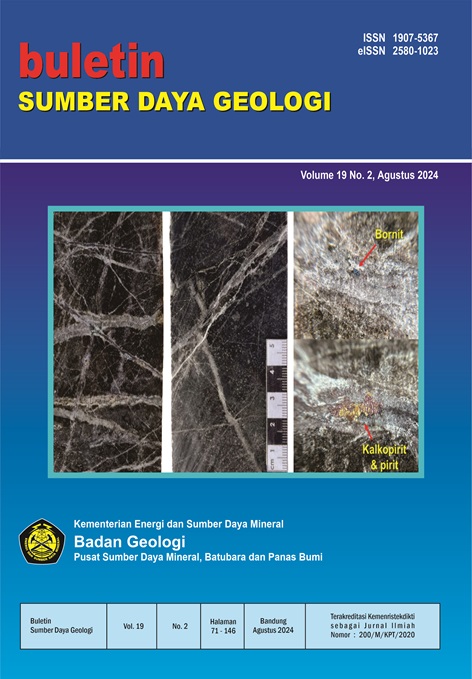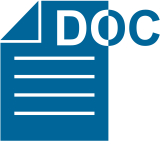KARAKTERISASI MINERALISASI TEMBAGA-EMAS BERDASARKAN GEOKIMIA MULTIUNSUR DENGAN METODE K-MEANS DAN ANALISIS KOMPONEN UTAMA, TOGURACI, INDONESIA
CHARACTERIZATION OF COPPER-GOLD MINERALIZATION BASED ON MULTIELEMENT GEOCHEMISTRY WITH K-MEANS AND PRINCIPAL COMPONENT ANALYSIS METHODS, TOGURACI, INDONESIA
Abstract
Multielement geochemical data processing with K-means and principal component analysis was carried out in the Toguraci, part of the Gosowong gold mine contract of work in North Halmahera Regency, North Maluku Province. Previous research has suggested that there is overprinting low sulphidation epithermal Au-Ag mineralization and Cu-Au porphyry. This research focused on 2 selected drill holes with a total of 540 samples that were analyzed for Au and 46 other geochemical elements. The purpose of this research is to determine the characteristics of the copper-gold mineralization, and its host rock with multielement geochemical analysis, in order to provide a guide for exploration activities. Multielement geochemical data processing with K-means produced 3 lithogeochemical clusters based on their immobile element composition, namely basalt and diorite which are the host rocks, and quartz vein. Principal component analysis shows consistent results for the 3 clusters, where the combination of PC1 and PC2 which cumulatively represented 46,32% of the variance, indicates high and low loading scores describing the association of immobile elements that separates basalt, diorite and quartz vein. Data simplification with 7 principal components (P1-PC7) representing 73,62% of the variance has produced 6 geological domains which have their respective geochemical characteristics, namely Quartz vein, Basalt-1, Basalt-2, Diorite-1, Diorite-2, and Diorite-3. Copper mineralization is found in Basalt-1 and Diorite-1 related to porphyry type that has characteristics of Mo-Cu-Re-Ge-Au elemental association. While gold mineralization is found in the Quartz vein domain related to low sulphidation epithermal type which is characterized by Ag-Sb-Te-Au-Tl-Bi-As-Pb-Se-In elemental association.
Downloads
References
Andrina, D. R., 2013. Characteristics of Porphyry Deposit in Toguraci and Tobobo Area, North Halmahera District, North Maluku Province, Indonesia. A thesis submitted for the degree of Bachelor of Geology at The University of Padjadjaran in May 2013. Unpublished.
Applied Petrological Services. 2001. Petrological Studies of Diamond Core and Surface Samples from The Toguraci and Tobobo Projects, Gosowong Epitermal Gold Project Area, Halmahera. PT. Nusa Halmahera Minerals. APS report 214, Project No. 3088.
Applied Petrological Services. 2001. Petrological Studies of Diamond Core and from The Midas and Damar Projects, Toguraci, Halmahera: Gold Paragenesis and Distribution Studies. PT. Nusa Halmahera Minerals. APS report 223, Project No. 03090.
Applied Petrological Services. 2004. Petrological Studies of Diamond Drill Core from The Toguraci Gold Prospect, Halmahera, Indonesia. PT. Nusa Halmahera Minerals. APS report 271, Project No. 03093.
Applied Petrological Services. 2005. Petrological Studies of Diamond Core from KMD012 of The Kayu Mati Prospect Area. PT. Nusa Halmahera Minerals. APS report 294, Project No. 03094.
Carlile, J.C., Davey, G.R., Kadir, I., Langmead, R.P., and Rafferty, W.J., 1998. Discovery and exploration of the Gosowong epitermal gold deposit, Halmahera, Indonesia. Journal of Geochemical Exploration, 60, h. 207 - 227.
Dempster, M., Dunlop, P., Scheib, A., and Cooper, M., 2013. Principal component analysis of the geochemistry of soil developed on till in Northern Ireland. Journal of Maps, 9:3, 373-389.
Goldschmidt, V.M., 1954. Geochemistry. Oxford University Press, Oxford, England, p. 730.
Halley, S., 2020. Mapping magmatic and hydrothermal processes from routine exploration geochemical analyses. Economic Geology, 115(3), pp.489-503.
Hotelling, H., 1933. Analysis of a complex of statistical variables into principal components. Journal of Educational Psychology, 24, 417–441.
Isfan., Harsono, A., Haris, A., 2021. Cluster Analysis of Lithology Grouping Trends using Principal Component Spectral Analysis and Complex Seismic Attributes. Makara Journal of Science. Vol.25.
Olberg, D.J., Rayner, J., Langmead R.P., and Coote, J.A.R., 1999. Geology of the Gosowong epithermal gold deposit, Halmahera, Indonesia, East Indonesia: Australasian Institute of Mining and Metallurgy Publication Series 4/1999, p. 179–186.
Pearson, K., 1901. On lines and planes of closest fit to systems of points in space. Philosophical Magazine 2, 11, 559–572.
PT. Nusa Halmahera Mineral. 2013. Peta Geologi Area Gosowong. Tidak dipublikasikan.
PT. Nusa Halmahera Mineral. 2013. Skematik Stratigrafi Area Gosowong. Tidak dipublikasikan.
Richards, T.H., and Basuki Dwi Priyono, M.D., 2004. Discovery of the Toguraci Epithermal Au-Ag Deposits, Gosowong Goldfield, Halmahera Island, East Indonesia. Australasian Institute of Mining and Metallurgy Publication Series 5/2004, p. 359–366.
Rollinson, H.R., 1993. Using Geochemical Data: Evaluation, Presentation, Interpretation. Longman Group UK Limited, 352p.
Sulistyawan, R.I.H., 2009. Studi Karakteristik Mineralisasi Sulfida di Gosowong Halmahera. Tesis Magister. Program Studi Magister Rekayasa Pertambangan. Institut Teknologi Bandung. Tidak dipublikasikan.
Copyright (c) 2024 Buletin Sumber Daya Geologi

This work is licensed under a Creative Commons Attribution-NonCommercial-ShareAlike 4.0 International License.
Authors whose manuscripts are published agree to the following terms:
The publication rights of all journal manuscript materials published on the Buletin Sumber Daya Geologi website are held by the editorial board with the knowledge of the author (moral rights remain with the manuscript’s author).
The formal legal provisions for access to digital articles in this electronic journal are subject to the terms of the Creative Commons Attribution-ShareAlike (CC BY-SA) license. This means that Buletin Sumber Daya Geologi has the right to store, convert media/formats, manage in the form of a database, maintain, and publish the article without requesting permission from the author, as long as the author’s name is cited as the copyright holder.
Manuscripts published in both print and electronic formats are open access for educational, research, investigative, and library purposes. Beyond these purposes, the editorial board is not responsible for any violations of copyright law.















